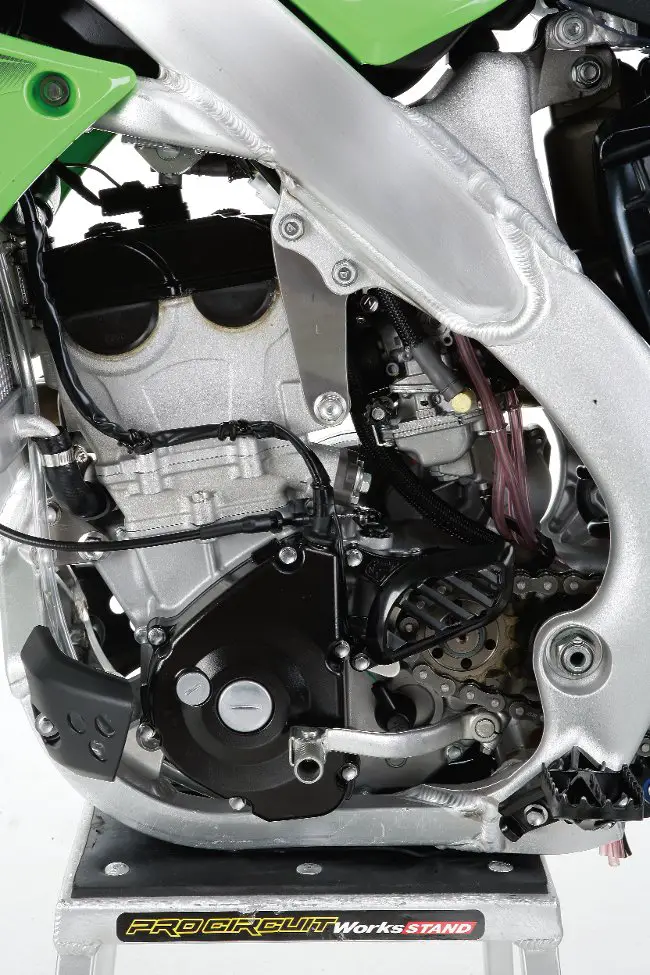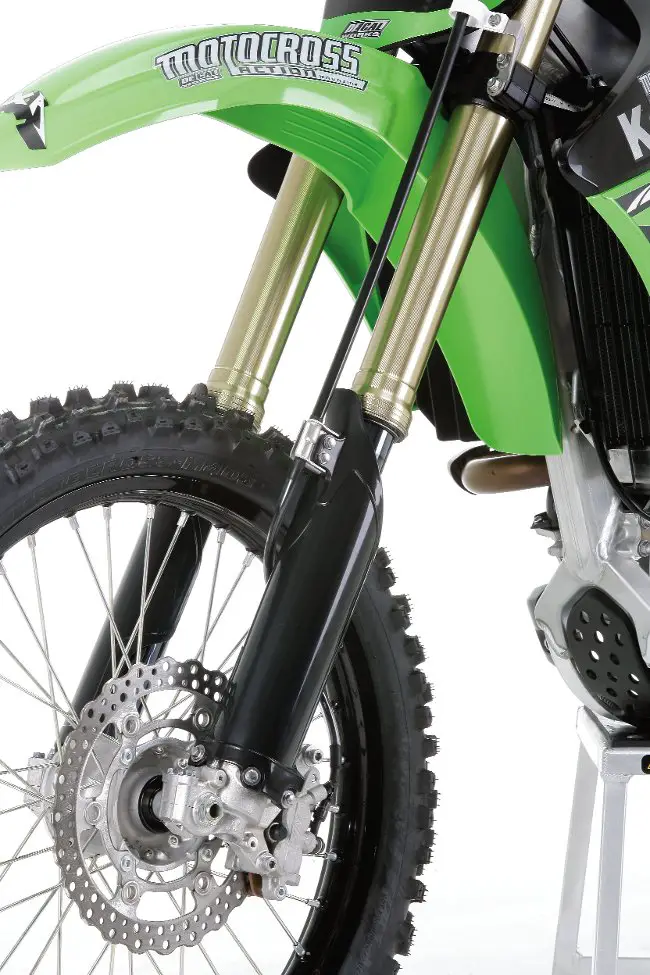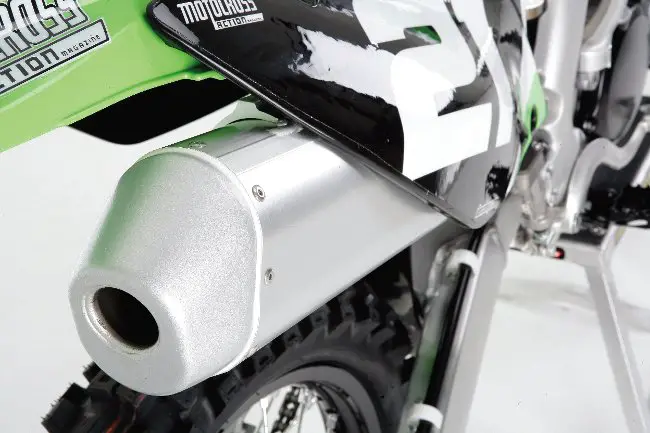REAL TESTS: 2010 MXA RACE TEST OF THE KAWASAKI KX250F:

2010 Kawasaki KX250F: The MXA wrecking crew has always loved the KX250F powerband, although we were not always enamored by the horsepower. For 2010, Kawasaki’s engineers made the power match the powerband. Kudos
Q: FIRST AND FOREMOST, IS THE 2010 KX250F BETTER THAN THE 2009 KX250F?
A: Yes. And it is better in the one place that makes the biggest difference in the 250 class (and the place where it was the weakest last year).
Q: WHAT ARE THE MAJOR CHANGES THAT KAWASAKI MADE TO THE 2010 KX250F?
A: Kawasaki has habitually made a series of updates (both major and minor) to every model year of the KX250F.
For 2010, Kawasaki stuck to the same regimen. The Kawasaki engineers made roughly 33 changes to six specific areas of the KX250F. Let us count the mods.
(1) Engine. The heart of the KX250F, the engine, received a new piston with a shorter skirt, added support ribs and reinforced box structure interior. The piston crown is 0.6mm higher for improved combustion, and the piston pin has been shortened from 45.1mm to 38.1mm for reduced reciprocating weight and quicker revving. The cylinder has a slightly taller height (36.0mm in 2009 to 36.5mm in 2010) in order to match the new piston compression ratio. Kawasaki returned to their proprietary electrofusion cylinder treatment after years of using plating technology. The electrofusion treatment improves oil retention, provides better resistance to piston seizure and reduces scorching.
Other engine changes include a 1mm-longer crank pin, wider connecting rod and bearing, and increased thickness of the copper plating on the connecting rod’s needle bearing cage. These crankshaft updates result in better heat dissipation, increased durability, and a cooler-running engine. The new oil pump rotors include a wider pump rotor (from 5mm to 5.5mm) for increased oil flow and a smaller scavenge pump rotor (from 11mm to 10.5mm) for reduced mechanical loss and to match the oil flow balance.
Kawasaki also beefed up the engine cases by increasing the thickness of the lower-front engine mount by 2mm. However, the frame mounts are unchanged from last year. The revised camshaft has increased spring set load on the auto-decompressor for easier starting.
The change improved the shifting characteristics of the KX250F, but there was still room for growth. MXA test riders had complained about notchy shifting and finding false neutrals between gears ever since 2004. To combat these problems, Kawasaki focused on several key areas.

Super: The 2010 KX250F engine makes awesome power.
(1) They revised the fourth input gear holding method by getting rid of the circlip and washer.
(2) They changed the shape of the second input gear. This way, second gear takes the load (instead of the clip and washer).
(3) The durability of fourth gear was increased.
(4) The dogs on the third input gear were also increased for more precise gear engagement and increased reliability.
(3) Radiators. The 2010 KX250F radiators are new. The radiator thickness has been increased from 22mm to 32mm, and the width of each radiator has been increased from 113.8mm to 117.8mm. The radiators have the same fluid capacity, but the fins are wider and spaced farther out. By making the radiators thicker and wider, Kawasaki was able to get rid of the mounting brackets and support stay. The radiators offer improved torsional rigidity and better resistance to mud buildup.
(4) Exhaust. The MXA wrecking crew can tell a lot about a bike just by the changes made to the exhaust pipe. Kawasaki was looking for better low-end performance and throttle response. How do we know? The head pipe is now tapered from 35mm to 45mm. The length of the preliminary bend in the header is increased by 30mm, while the midpipe section following the heat shield has been shortened by 30mm. The head pipe material has been changed from titanium to stainless steel to cut costs. The muffler has a new joint shape, clamp design and rubber mount. It should be noted that an aftermarket exhaust system from the 2009 KX250F will fit on the new model.
(5) Forks. The 47mm Showa Twin-Chamber forks have new damping settings that focus on forward lean, better front/rear balance, smoother action and increased absorption. The steering stem shaft has been decreased from 24mm to 23mm for reduced rigidity, lighter handling, and improved front wheel tractability. The 23.5mm triple clamp offset remains the same as last year.
(6) Shock. The Showa shock has new damping settings for smoother action and increased absorption. Other changes in the shock area include a revised rear linkage ratio, thanks to a new pullrod and rocker arm. The new pullrod is 1mm longer than last year’s rod. The lengthened link arm improves stability and reduces wallowing under acceleration.
(7) Chassis. For the second year in a row, Kawasaki changed the shape of the KX250F swingarm. The “D” shape has been revised by decreasing the wall thickness and inside rib height. Kawasaki’s aim was to reduce rigidity while improving handling and cornering. The black wheels have a new rim design for strength and weight savings. The rims have a taller profile and narrower width. Overall weight savings of the new rims is 80 grams. Kawasaki also cut weight with the chain. The thickness of the drive chain has been decreased from 2mm to 1.8mm. The narrower chain plates account for a 20-gram weight savings. Other chassis updates include new rear brake pads (material and insulation have been changed for an improved feel), a thicker front fender, and a firmer urethane seat.
Q: HOW FAST IS THE 2010 KX250F?
A: Horsepower doesn’t mean squat if it’s not distributed properly throughout the powerband. An engine can produce tremendous horsepower numbers but be a slug on the track. Conversely, a weak engine on the dyno can feel like a rocketship on the track.
Take last year’s KX250F, for example. It produced the least amount of horsepower in the field, yet it was easily the second best engine in the class. Why? Kawasaki was able to efficiently distribute the spread of power in strategic areas that were beneficial to the rider. These areas included the midrange (8000 to 10,000 rpm) and top-end (10,000 to 12,000 rpm).

Track: The Kayaba forks aren’t perfect, but they are ballpark.
Effective use of the KX250F powerband requires little more than a quick throttle wrist. The bike topples the competition by punching hard just below the midrange and ripping into the top-end. Flubbing a corner requires judicious use of the clutch, but unlike the KTM 250SXF or Husqvarna TC250, the KX250F can regain composure quickly instead of falling off the pipe.
Q: HOW WOULD WE DESCRIBE ALL OF THE 2010 250F POWERBANDS?
A: Borrowing a few lines from “Goldilocks and the Three Bears,” the 2010 KTM 250SXF engine is too hot, the Honda CRF250 engine is too cold, the Husky TC250 is too mild, and the Yamaha YZ250F is too much too soon.
Where does the 2010 Kawasaki KX250F engine fit into this scheme? It’s just right. We would pick the broad and usable powerband of the KX250F over every other 250 four-stroke that we’ve tested (the 2010 Suzuki RM-Z250 was not made available for testing during the test period). The 2010 KX250F engine is the perfect racing weapon. It is the best engine for every skill level. Yes, it’s that good.
Q: HOW DOES THE 2010 KX250F RUN ON THE DYNO?
A: Maximum horsepower on our 2010 KX250F was 36.48 ponies at 12,000 rpm. Maximum torque was 19.53 foot-pounds. For comparison, our 2009 KX250F reached 35.45 horsepower at 10,800 rpm and produced 19.07 foot-pounds of torque.
Most impressive is that the 2010 KX250F is over a horsepower stronger than the 2009 model throughout the entire dyno curve. It especially stands out from 9000 to 12,000 rpm. The increase in top-end power is a direct result of the high-compression piston and shorter head pipe.
Last year, the KX250F had the least peak horsepower in its class. No more! Compared to its competition, the 2010 KX250F falls one-half of a pony behind the horsepower-leading KTM 250SXF, but is much better than the KTM up to the KX250F’s peak (after that the KTM is unmatched). The KX250F boasts the second most horsepower in the class, meaning that the CRF250, YZ250F and TC250 fall short. We commend Kawasaki for doing their homework and improving the power characteristics of the KX250F. Not only did Kawasaki pump up the ponies on the 2010 KX250F, but they stuck with their almost perfect motocross powerband.
Q: DOES THE 2010 KX250F PASS THE AMA SOUND TEST?
A: Yes. The AMA’s mandated sound rules state that a 250cc four-stroke must meet 94 dB. Thanks to a 1.9 dB leeway, a 250F can be 95.9 dB at 5000 rpm and still pass the sound test. The 2010 Kawasaki KX250F easily passes the AMA sound test at 93.5 dB. Only the KTM 250SXF (92.0 dB) is quieter than the KX250F, while the YZ250F (95.5 dB) and CRF250 (96.5 dB) are much louder.
There is one enormous caveat. The sound test numbers are, however, deceiving. Although the KX250F is quiet at 5000 rpm, above that the bike shrieks. It is far and away the loudest bike in a racing rpm range. The 2010 KX250F will pass the loose AMA sound rule but will cause ears to bleed from 8000 rpm through 12,000 rpm.
Q: WHAT WOULD BENEFIT THE 2010 KX250F THE MOST?
A: We have two quibbles.
(1) Gearing. Our biggest problem with the 2010 KX250F is that the gearing is too tall for mere mortals. No surprise. We have had gearing and gearbox issues with every KX250F. The 48-tooth rear sprocket hampers engine performance, especially on tight tracks. The stock tranny also has a black hole-sized gap between second and third gear, so we jumped to a 49-tooth sprocket. Not only did the extra tooth close the gap between the offending gears, but it helped liven up the engine. Nearly every skill level rider (pros exempt) would benefit from an extra tooth on the rear sprocket.
(2) Handling. Although not unridable, the 2010 KX250F is still lackluster when it comes to handling traits. We give Kawasaki credit for trying to solve the problems, but credit isn’t the same as a big “Attaboy!” For 2010, Kawasaki decreased the size of the steering stem shaft and lengthened the pullrods and rocker arm. By changing the flex characteristics and linkage ratio, Kawasaki hoped that the 2010 KX250F would no longer push on the exit of corners or wallow under acceleration. The changes were noticeable, but they didn’t eradicate the issues. MXA test riders complained about the bike’s tendency to push from center-out (especially at the apex of corners and on fast sweeping turns).
A solution to the handling problem is to invest in 22mm offset aftermarket triple clamps. The handling becomes more precise and the front-end feels more planted, thanks to the increased trail.
Q: HOW IS THE KX250F JETTING?
A: Last year, the stock mainjet was too rich for most conditions. We dropped the mainjet, richened the pilot jet and leaned out the fuel screw. For 2010, Kawasaki went to an even richer mainjet, but they also leaned out the fuel screw. We believe that Kawasaki went richer on the mainjet to help decrease the decibel level. Surprisingly, aside from fine-tuning the fuel screw, we didn’t have any major issues with the jetting.
MXA‘s recommended jetting is as follows (stock settings are in parentheses):
Mainjet: 185
Pilot: 40
Needle: NHJT
Leak jet: 55
Clip position: 4th from top
Fuel screw: 1-3/4 turns out (2 turns out)
Notes: The NHJT needle was new last year. The taper has a gradual progression (unlike the 2008 needle, which was stepped).
Q: HOW GOOD IS THE SHOWA SUSPENSION ON THE KX250F?
A: Kawasaki changed the damping settings on the 47mm Showa forks and Showa shock. They hoped for smoother action and improved absorption. Did their refinements work? Yes, but it’s not an overwhelming improvement over the suspension package on the 2009 KX250F. The suspension is still prone to swift bottoming in the hands of a heavy or fast rider, but the Showa components will do a fine job for lighter riders.
In any previous test, the KX250F’s suspension would have been compared unfavorably to Yamaha’s superb Kayaba SSS components, but for 2010, Kayaba missed the mark on the Yamaha YZ250F. Showa might earn bragging rights this year with the KX250F suspension, but only because Kayaba shot themselves in the foot.

Parlor trick: The 2010 KX250F may pass the AMA’s 5000 rpm sound test, but it is incredibly loud at speed.
Q: WHAT ARE MXA’S RECOMMENDED 2010 KAWASAKI KX250F FORK SETTINGS?
A: Here is what the MXA wrecking crew ran in its 2010 Kawasaki KX250F (stock settings are in parentheses):
Spring rate: 0.44 kg/mm
Oil height: 306cc
Compression: 8 clicks out (10 clicks out)
Rebound: 8 clicks out (9 clicks out)
Fork leg height: 5mm up (7mm up)
Notes: If you have to go less than six clicks out on compression, you should step up to the next stiffest spring rate.
Q: WHAT IS MXA’S RECOMMENDED KX250F SHOCK SETTING?
A: Here is what the MXA wrecking crew ran in its 2010 Kawasaki KX250F (stock settings are in parentheses):
Spring rate: 5.4 kg/mm
Race sag: 100mm
Hi-compression: 1-1/4 turns out (2-1/4 turns out)
Lo-compression: 8 clicks out (11 clicks out)
Rebound: 9 clicks out (11 clicks out)
Notes: We think that the KX250F works best with the low-speed compression turned in while using the high-speed to adjust the ride height at speed.
Q: HOW DOES THE 2010 KX250F HANDLE?
A: The MXA wrecking crew is not in love with the handling traits of the 2010 KX250F, but that’s not to say that the KX250F can’t be fixed. In stock form, the front end pushes from center-out in corners. It’s a sensation that requires adaptation, but in the simplest terms, the KX250F doesn’t feel planted.
Never willing to accept mediocrity, MXA test riders tried everything under the sun to improve the KX250F’s handling traits. We slid the forks up in the clamps, messed with race sag, and turned in the low-speed compression on the shock. Handling improved, but several test riders still yearned for even sharper turning. The solution? Since the Kawasaki factory riders run 22mm offset triple clamps, the answer was right under our noses. With the 22s, the front end tracked straighter and had a more planted feel.
Q: WHAT DID WE HATE?
A: The hate list:
(1) Gearing. In stock trim, the 48-tooth rear sprocket is too tall for all but expert riders. Find happiness by investing in a 49-tooth sprocket.
(2) Handling. Kawasaki tried to address our handling complaints, but they didn’t take the ball and run with it. The 2010 KX250F handles slightly better than the 2009 model, but that’s really not much of a compliment.
(3) Rear axle. We’ll complain about Kawasaki’s rear axle cotter pin until we’re blue in the face. Kawasaki’s lawyers recommend placing a cotter pin through the rear axle for safety. We threw away the cotter pin and put on a self-locking Honda rear axle nut.
(4) Exhaust. The KX250F exhaust passes sound at the mandated AMA sound test, but above 5000 rpm it is by far the loudest bike in the 250F class.
(5) Throttle grip. Kawasaki vulcanized the grip to the throttle tube on the KX250F, making it extremely difficult to replace the stock grip. Doing so requires time, patience, a razor blade and a possible trip to the emergency room. Or, you can spend $50 on an aftermarket aluminum throttle tube.
(6) Plastics. The KX250F’s bodywork might as well be made out of rice paper. We cracked the shrouds and broke a fork guard in the first five hours.
Q: WHAT DID WE LIKE?
A: The like list:
(1) Engine. This baby is a screamer! Every single MXA test rider loved the performance of the KX250F engine. Kudos to Kawasaki for pumping more power into the engine.
(2) Suspension. The Showa units work relatively well. They don’t stand out in any specific area, but they are workmanlike.
(3) Shifting. Two years ago, shifting was on our list of complaints. However, changing the second input gear shape and increasing the third input gear dogs makes shifting more precise than it was last year.
(4) Appearance. The black and green motif, especially with the black number plates and engine guards, makes the 2010 KX250F look like a modern version of KITT from Knight Rider.
(5) Tire combo. We like the Bridgestone M403/M404 sneaker combo on the KX250F. These tires work very well in intermediate to hardpack.
Q: WHAT DO WE REALLY THINK?
A: The two most important areas on a 250 four-stroke are the engine and the handling. The 2010 Kawasaki KX250F aced one area (engine), but only gets a “fair” in the other (handling). The question is whether the MXA test crew is able to overlook the push from center-out in corners because of the amazing engine. The short answer? Yes.






Comments are closed.